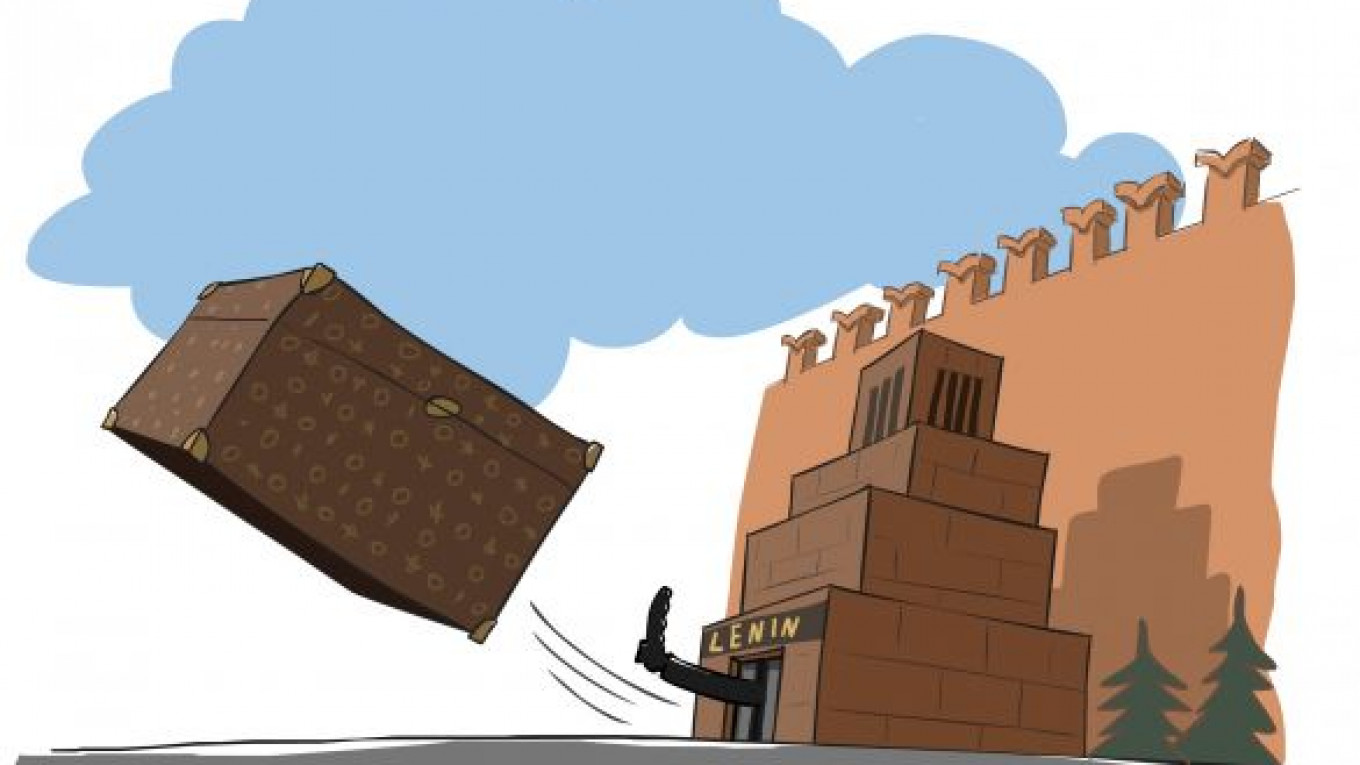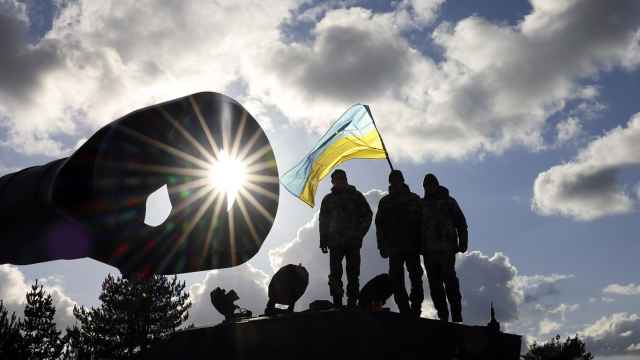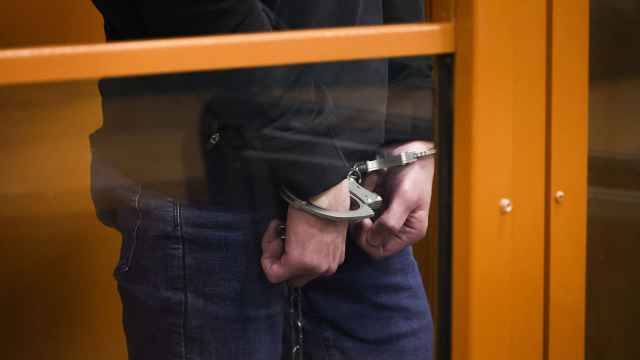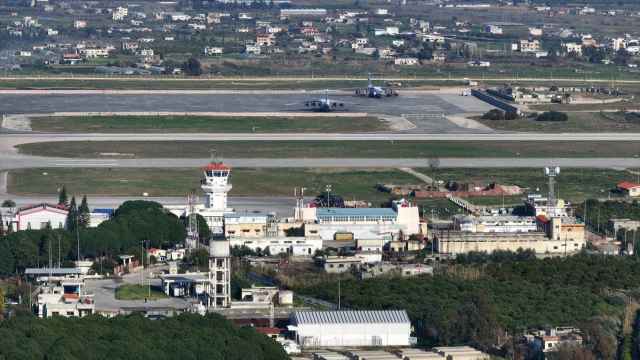A team of workers toiled for several weeks to erect a giant replica of a Louis Vuitton trunk on Red Square. But on Nov. 26, just one day after the structure was finished, the authorities ordered that the suitcase be hastily dismantled.
Perhaps it was not a coincidence that President Vladimir Putin was returning from a trip to Italy the next day, and authorities in the presidential administration were worried that he would not be pleased to see the garish sight on the country's sacred Red Square and a stone's throw from the Kremlin.
As Moscow is home to 78 billionaires and more than 100,000 millionaires, placing the huge Louis Vuitton trunk on Red Square seemed fitting.
The 30-meter-long, 9-meter-tall edifice was to house a temporary exhibit of Vuitton baggage, "The Soul of Travel," in honor of the 120th anniversary of the nearby GUM department store. The travel bags of a dozen historic figures including Nicholas II, Ernest Hemingway and Catherine Deneuve would have been on display. To add a dash of local color, the initials of 19th century Prince Vladimir Orlov were inscribed on the sides of the case, which was draped with a Russian tricolor flag. Proceeds from ticket sales would go to charity, although the charity was run by the girlfriend of the son of Louis Vuitton chief Bernard Arnault.
The Vuitton exhibit took conspicuous consumption to a new level. Right there in front of Lenin's Mausoleum, it stood in gratuitous celebration of the inequalities that market capitalism have brought to Russia. Predictably, Communist and nationalist deputies in the State Duma were apoplectic. Putin cannot afford to alienate these politicians, whose voters represent the core of his own base of support.
Throughout Russian history, Red Square has been a site for the formal rituals of church and state. It was also used for more mundane commercial activity, now represented by the upscale GUM department store. Since the fall of the Soviet Union, the debates over Russian identity have spilled out onto the cobblestones of Red Square. In 2003, the square was packed with fans singing "Back in the U.S.S.R." when Putin gave former Beatle Paul McCartney permission to play a concert there. In July, Christian Dior held a fashion show, without incident.
A similar giant trunk had been displayed in Paris in May of this year and in Shanghai in 2011. So putting one in Moscow — home to 78 billionaires, the highest concentration in the world, and more than 100,000 millionaires — seemed logical and fitting.
But the Vuitton stunt came at a particularly inopportune time in Russian politics. Putin is currently in the midst of a drive to "nationalize" the Russian ruling class by forcing civil servants and politicians to declare their income, major purchases and property (both foreign and Russian). They also have to close any foreign bank accounts and sell their foreign stocks and bonds. But of the millions of civil servants, only eight officials have been fired thus far based on these new rules. But bureaucrats are afraid that more heads may roll if Putin feels the need to steal the thunder of the opposition's campaign against corruption.
This campaign, known as "de-offshorization," was initiated in response to the winter 2011-12 protests, when tens of thousands of Muscovites took to the streets to denounce the ruling United Russia party as nothing but "crooks and thieves."
The Vuitton suitcase evoked not only wealth and luxury but also escape. It is no secret that Russia's wealthy have their Vuitton and other bags packed, ready to head to the West at the next sign of political instability or a government crackdown on the oligarchs. Their money, and in many cases their families, are already parked in the West. It was thus richly symbolic that the pavilion was not a travel bag or suitcase, but a huge trunk — for a one-way trip out of Russia.
The super-rich aside, ordinary Russians certainly appreciate the right to travel without having to get state permission, a sharp contrast to the sealed borders of the Soviet era. But in practice, only about 20 million Russians can actually afford to vacation abroad.
Now that the suitcase has gone, debate has shifted to finding who is to blame. The GUM store insisted that all necessary permits had been obtained. The Moscow City mayor's office said the president's Federal Security Service was responsible for Red Square. But an FSB spokesman said that the Culture Ministry deals with structures erected on the square.
This serves as small example of the bureaucratic labyrinth that is stifling Russia's economic development. This is the same bureaucracy that enables the rich to flourish, while little of their wealth trickles down to ordinary Russians.
Peter Rutland is a professor of government at Wesleyan University in Middletown, Connecticut. Francesca di Tonno is an independent researcher and consultant at PR Russia-Italy.
A Message from The Moscow Times:
Dear readers,
We are facing unprecedented challenges. Russia's Prosecutor General's Office has designated The Moscow Times as an "undesirable" organization, criminalizing our work and putting our staff at risk of prosecution. This follows our earlier unjust labeling as a "foreign agent."
These actions are direct attempts to silence independent journalism in Russia. The authorities claim our work "discredits the decisions of the Russian leadership." We see things differently: we strive to provide accurate, unbiased reporting on Russia.
We, the journalists of The Moscow Times, refuse to be silenced. But to continue our work, we need your help.
Your support, no matter how small, makes a world of difference. If you can, please support us monthly starting from just $2. It's quick to set up, and every contribution makes a significant impact.
By supporting The Moscow Times, you're defending open, independent journalism in the face of repression. Thank you for standing with us.
Remind me later.






